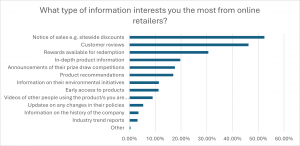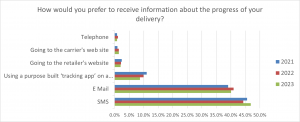By Ellie-Rose Davies, Content Executive at IMRG
SMS marketing has become a popular channel for retailers, offering a direct and effective way to connect with customers. With a growing preference for SMS updates, this blog helps retailers to refine their SMS strategies.
Industry experts have provided their advice on these topics:
- Growing SMS opt-ins at the point of purchase (online and in-store)
- Integrating SMS sign-ups in loyalty schemes
- Examples of good SMS content
- Using SMS for post-purchase engagement
Read on to discover actionable tips and insights.
Growing SMS opt-ins at the point of purchase (online and in-store)
Retailers can boost SMS opt-in rates by promoting it at the point of purchase, whether that’s online or in-store.
Burc Tanir, CEO at Prisync says, ‘A simple opt-in prompt at purchase, paired with a clear incentive, followed by personalised post-purchase messages, encourages customers to join your SMS list. The objective is to make the opt-in feel like a natural part of their shopping journey.’
Here’s how retailers make it a natural part of the online journey:
- Make it visible and outline benefits: Retailers can position the SMS opt-in checkbox prominently on the checkout page, ensuring it is clearly labelled so customers understand what they are subscribing to. Wording such as “Sign up for SMS updates to receive exclusive discounts and order notifications” can be effective.
- Consider placement: Retailers can test the placement of the opt-in box, where they may put it near the order confirmation details, the ‘pay now’ button, or even on the payment confirmation page to entice loyalty.
- Provide opt-in confirmation: Once a customer opts in, retailers may wish to send a confirmation SMS thanking them for subscribing and outlining the benefits they will receive. At this point, they may even wish to provide a “thank you” gift.
For brick-and-mortar stores, integrating SMS opt-ins into the in-store purchase process requires a slightly different approach:
- At the tills: Retailers can train staff to ask customers if they would like to receive SMS updates during the checkout process. This can be as simple as, “Would you like to sign up for our SMS updates to get the latest offers and notifications?” They can ensure staff are well-versed in the benefits to effectively communicate them.
- Digital and physical promotion: Retailers can optimise in-store signage near checkout areas that promotes SMS sign-up. For instance, a poster or digital screen could display a QR code that customers can scan to easily sign up for SMS updates. They can also include this as customers sign into their loyalty accounts on digital screens.
- Receipt communication: Include a QR code or short URL on printed or digital receipts encouraging customers to opt in for SMS updates. For example, “Text ‘JOIN’ to 12345 to receive exclusive deals and updates!”
Integrating SMS sign-ups in loyalty schemes
One of the most effective ways to increase SMS sign-ups is through making them part of loyalty schemes. Often, the benefits of loyalty schemes mean that customers would be more willing to provide their number.
According to Bill Schneider, VP of Product Marketing at SheerID, ‘SMS marketing can be highly effective when you engage customers with actionable messages. A whopping 91% of customers express a desire to receive text messages from businesses and 90% say they have found value in SMS loyalty programs, according to G2.’

Bill says, ‘Sending a gated offer that’s unique to the customer’s community, like college students or teachers, is a particularly effective way to earn the customer’s opt-in for personalised communication and offers for their community.’
Burc Tanir at Prisync agrees, stating that, ‘Driving SMS opt-ins effectively requires integrating them where customers are already engaged—loyalty programs offering exclusive discounts or early sales access are perfect for this.’
‘Take IKEA, for example—they use SMS to notify customers about restocks, product launches, and special events, building loyalty through the IKEA Family program. Klaviyo’s 2024 stats show that 42% of consumers want SMS coupons, and 33% value loyalty offers.’
Lisa Angel is another excellent example of a retailer leveraging their loyalty scheme to increase SMS engagement. During the account creation process, they prompt customers to choose their preferred communication channels from a list of options, each accompanied by specific loyalty benefits. For instance, customers can select ‘Email +100 Reward Points’ or ‘SMS +50 Reward Points’.
Examples of good SMS content
Once customer’s opt-in to SMS communications, retailers can enhance their messaging to align with customer expectations and minimise unsubscribe rates.
When we (IMRG and Epsilon) asked 1,000 UK customers what type of information interests them the most from online retailers, we gained some good quantitative data that can help inform retailers’ SMS content strategies (see chart).

Source: ‘Build Lasting Customer Connections With Better Digital Experiences’ report, IMRG and Epsilon, 2023
The survey revealed that customers primarily want to receive information about sales, such as sitewide discounts. They also appreciate updates on rewards available for redemption. Less popular are industry trend reports and updates to changes in policies.
Lee Smorthit, Retention Marketing Lead at Dark Matter Commerce describes how ‘Offering exclusive discounts, early access to sales, or VIP perks as incentives can entice customers to subscribe. The most effective SMS content includes time-sensitive offers, order updates, and cart abandonment reminders, which leverage SMS’s immediacy to drive quick engagement.
He continues, ‘Pairing SMS with email campaigns maximises retention and conversion rates by utilising SMS for immediate alerts and email for detailed information. Retailers adopting SMS marketing can significantly enhance customer engagement, increase repeat purchases, and recover lost sales.’
Using SMS for post-purchase engagement
Data from our Consumer Home Delivery report reveals a notable trend: SMS consistently emerges as the preferred channel for customers to receive delivery updates, even surpassing email. This highlights the crucial role of SMS in enhancing the post-purchase experience.

Source: IMRG and nShift’s ‘Consumer Home Delivery Report 2023/4’
Nick Williams, Parcel Services Director at PayPoint exclaims, ‘SMS marketing continues to hold significant value for eCommerce sector, including those in the parcels sector. It offers a direct line to customers for critical updates on their parcel’s status, such as dispatch and delivery notifications, as well as improving overall service experience.’
‘Additionally, it’s an efficient channel for circulating promotions and discounts or personalising communications, which can both support growth in revenue and customer retention,’ says Nick.
For more complex post-purchase SMS messages, retailers can include clear calls-to-action. For instance, if a customer needs to reschedule a delivery or provide additional information, retailers may ensure that they can easily respond or act directly from the SMS using relevant links or instructions.
The timing of the message is also crucial. Retailers should aim to send SMS updates at appropriate moments—such as immediately after a purchase, when the order is dispatched, and upon delivery—so customers remain informed and engaged throughout their purchasing journey.
Personalisation adds further value. Examples of effective post-purchase SMS communication include using the customer’s name and specific details about their purchase, as well as promoting related products that complement their recent purchase.
Want to read more? Here are some other IMRG blogs that cover a range of eCommerce topics:
Ecommerce for Niche Markets: Strategies and Success Stories – IMRG
Mastering Mobile Commerce: Enhancing Apps, UX, and Conversion Strategies – IMRG
Top 11 Commerce Trends For Retailers In 2024 – IMRG
Brexit’s Impact On Retail And The Marketplace Opportunity To Thrive – IMRG
Top Cross-Border eCommerce Trends In 2024 – IMRG
Published 14/08/2024


